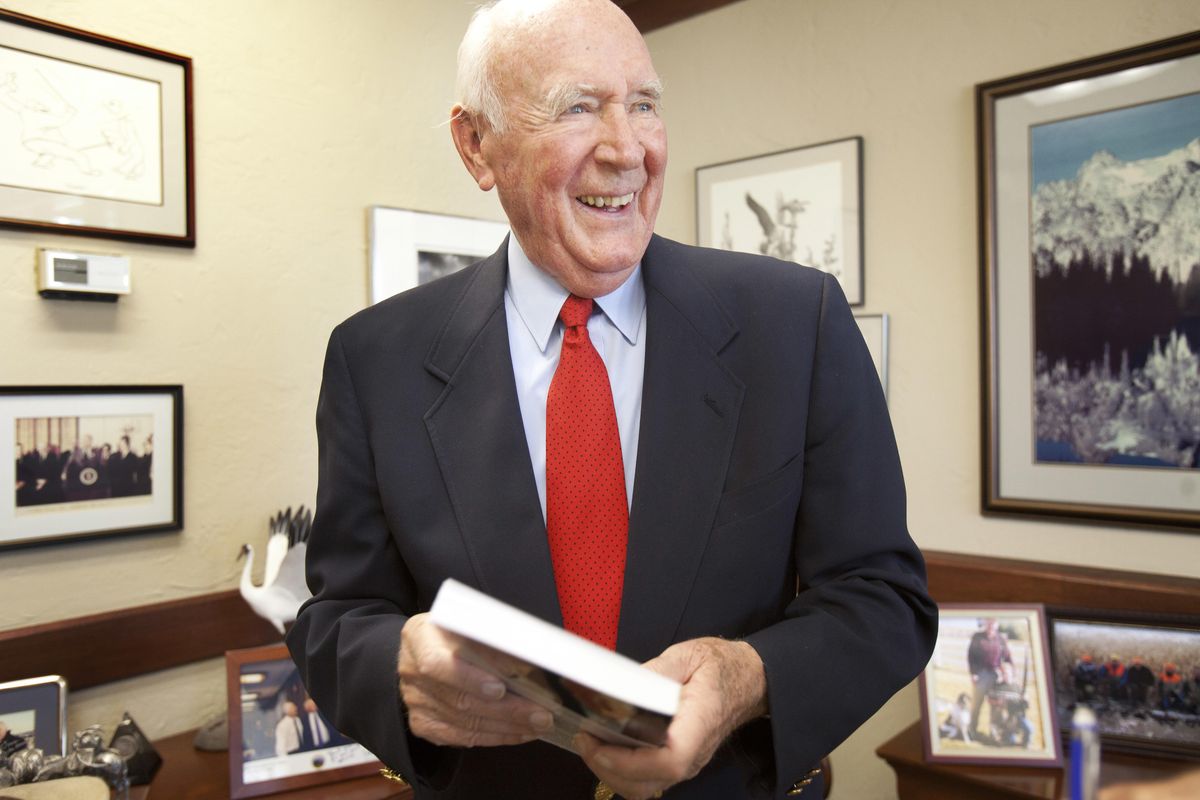Cecil Andrus, Idaho icon who championed wildnerness and kindergarten, dies at 85

Cecil Andrus, Idaho’s longest-serving governor, former U.S. Secretary of the Interior, Democrat and champion of wilderness and the Idaho outdoors, died late Thursday after a battle with cancer, the day before his 86th birthday.
“This is one of those times when you can really say it marks the passing of an era,” Marc Johnson, Andrus’ former chief of staff and press secretary, said on Facebook. “And I fear they aren’t making them like this any more…a great, great man.”
Andrus died at home, surrounded by his family and with his beloved bird dog, Maisy, by his side. He is survived by his wife Carol – they were married in 1949 – and by daughters Tana, Tracy and Kelly and grandchildren Monica, Morgan and Andrew and great granddaughter Casey.
Johnson said while it’s a sad day, it’s also a “wonderful opportunity to focus for a few minutes on the guy’s incredible impact and legacy. … It’s quite an astounding story.”
An Orofino lumberjack spurred to run for office by concerns over the local schools, Andrus became an Idaho icon who, after big fights, brought kindergarten to Idaho; increased school funding; halted a major coal power plant proposed near Boise; and engineered protection of Idaho’s famed wilderness areas.
“He’s one of the giants of Idaho politics and one of the most effective governors in Idaho history,” said longtime Idaho political observer Jim Weatherby, an emeritus professor at Boise State University. “His priorities were clear. … Andrus was a strong leader who also knew the fine art of compromise.”
“The electoral stuff kind of speaks for itself, winning four times in three decades in a very Republican state, winning as a Democrat,” Johnson said. “The secret sauce for his success was that he really liked people, and he loved to mix it up and have a good time and talk to people and joke around and engage them. And he was a real person – comfortable in his own skin.”
It was education – concerns about the local schools as his oldest daughter started elementary school – that first got Andrus into politics. He served four terms in the state Senate before first running for governor in 1966.
“I’m the only person in America that has run for governor twice in the same year and lost both times,” he said in an interview in May of 2016.
Andrus lost the primary to Charles Herndon, but then Herdon died in a plane crash, and Andrus became the Democratic nominee, but lost the general election. Four years later, he challenged GOP Gov. Don Samuelson and won.
Andrus attributed his victory to traveling the state widely and making the case that Idaho had enough revenue, but it wasn’t putting enough of it into education.
“They kept wanting to give it away, just like they are today,” he said, through tax cuts.
He was re-elected as governor and then named Interior secretary under President Jimmy Carter, where he was known for securing the passage of the Alaska Lands Act, among other accomplishments.
After returning to private life, Andrus ran for governor again in 1986 and again was both elected and re-elected. He famously closed the state’s borders to nuclear waste shipments in 1989, launching a fight against the federal government over waste headed for eastern Idaho’s Idaho National Laboratory site that Andrus continued waging until his death.
Education and the environment dominated Andrus’ agenda as governor, both in his first two terms, before he became secretary of the interior, and his later two.
“There were only two states in America that didn’t have kindergartens, and it was Mississippi and Idaho,” he recalled. “We were tied for last. But it took me five sessions of the Legislature to get it passed.”
“We were also increasing the funding for 1-12 – now it’s K-12,” he said. He recalled Idaho teachers taking jobs across the state line and commuting because the pay was so much higher elsewhere. “If you want good teachers, you’ve got to compete.”
He went toe-to-toe with Idaho Power Co. – which some at the time joked was so powerful in the early 1970s that the state had been named after it – to halt a proposed coal-burning power plant 30 miles from the state Capitol. In addition to serious health and economic concerns, Andrus said the proposed plant would have “made Boise a far less attractive place to live.”
Wilderness designations were landmarks of Andrus’ career, including fighting against logging interests to establish the Frank Church-River of No Return Wilderness.
Always an avid outdoorsman, Andrus said in May 2016, “I have hunted and fished every year, all my life, and I still do.”
Funeral arrangements, which will be private, are planned for Wednesday in Boise. A public lying-in-state ceremony will follow at noon on Wednesday in the Idaho Capitol rotunda and continue until noon on Aug. 31. A public memorial service is planned for 2 p.m. Thursday, Aug. 31, in the Jordan Ballroom of the Boise State University student union.
Andrus’ career is unique in the GOP-dominated Gem State. When he was first elected governor in 1970, he was the first Democrat elected Idaho governor in 24 years; his election launched a matching 24 years of Democratic control of Idaho’s governorship that didn’t end until Republican Phil Batt succeeded him in 1994.
Now, Idaho’s been under GOP control for 23 years – it’ll be 24 years next year, when Gov. Butch Otter retires after three terms, leaving an open seat for what’s expected to be a hotly contested election.
